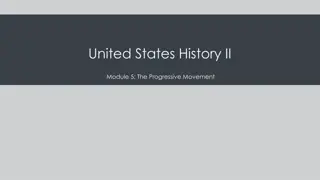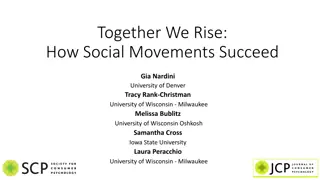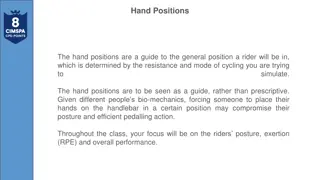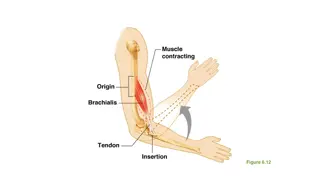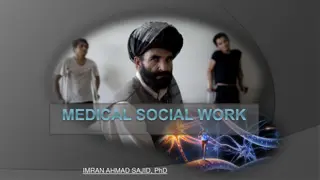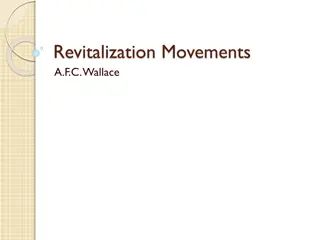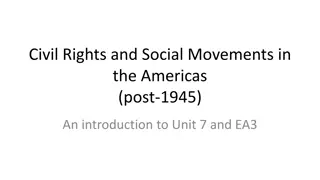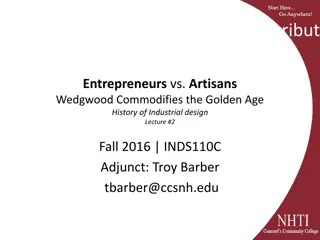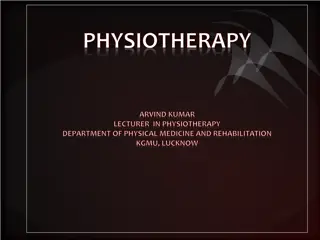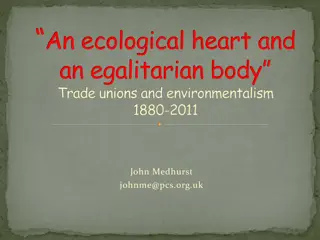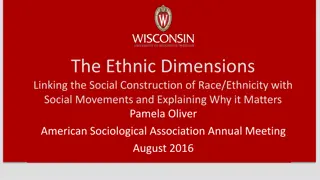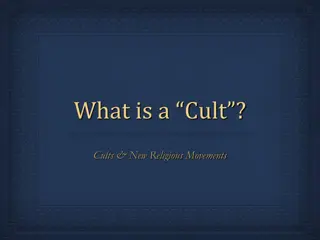Understanding Social Movements: History and Impact
Exploring the background and significance of social movements, this content delves into the evolution of society through various movements like the anti-slavery movement and labor movement. It discusses the types of movements, leaders, followers, tactics, and ways in which social movements can face resistance. Additionally, the history of social movements, from the times of John Wilkes to modern-day movements, is highlighted, emphasizing the role of collective behavior in driving social change.
Download Presentation

Please find below an Image/Link to download the presentation.
The content on the website is provided AS IS for your information and personal use only. It may not be sold, licensed, or shared on other websites without obtaining consent from the author. Download presentation by click this link. If you encounter any issues during the download, it is possible that the publisher has removed the file from their server.
E N D
Presentation Transcript
Social Action 6thSemester, BS Social Work Department of Social Work, University of Peshawar Instructor: Asif Khan
Learning Outcomes. Background History of Social Movements Definitions of Social Movements Types of Movements Types of Leaders Types of Followers Types of Tactics Characteristics of Social Movements 4 Ways in which Social Movements can be resisted 1. 2. 3. 4. 5. 6. 7. 8. 9.
1. Background If we look back upon the history of any society ,we would definitely find that much of it consist of the stories of the Struggles of groups within the society to change some aspect of the culture. This is one reason why history books are filled with content of the movements, and the terrors of revolutions. The crusades, the reformation , the French and American revolutions, the anti-slavery movement, the labour movement, fascism and communism- these like many other social movements have been accompanied by far reading changes in the societies which they touched.
Contd. Social Movements are conventionally regarded as part of the subject matter of collective behaviour , but they might just have as well be viewed as an aspect of social change. The study of social movements is primarily a study of social change as well as cultural change of a changing values and norms. In other words of Sherif and Sherif, A social movement is always possessed by a sense of mission. Hence, Attention is focused on the interaction of conscious, determined human beings as part of an emergent collectivity which is the social movement.
2. History of Social Movements The first mass social movement catalyzed around the controversial political figure John Wilkes.As editor of the paper The North Briton,Wilkes strongly attacked the new administration of Lord Bute and the peace terms that the new government accepted at the 1763 Treaty of Paris at the end of the SevenYears'War. Charged with rebellious defamation, Wilkes was arrested after the issue of a general warrant,a move that Wilkes denounced as unlawful - the Lord Chief Justice eventually ruled in Wilkes favour. As a result of this, Wilkes became a figurehead to the growing movement for popular sovereignty among the middle classes - people began chanting "Wilkes and Liberty" in the streets.
Contd. After a later period of exile brought about by further charges of libel and vulgarity, Wilkes stood for the Parliamentary seat at Middlesex, where most of his support was located. When Wilkes was imprisoned in the King's Bench Prison on 10 May 1768, a mass movement of support emerged, with large demonstrations in the streets under the slogan "No liberty, no King. Exposed of the right to sit in Parliament, Wilkes became an Alderman of London in 1769, and an activist group called the Society for the Supporters of the Bill of Rights began aggressively promoting his policies.This was the first ever sustained social movement: it involved public meetings, demonstrations, the distribution of pamphlets on an unprecedented scale and the mass petition march.
Contd. However,the movement was careful not to cross the line into open rebellion; - it tried to rectify the faults in governance through appeals to existing legal precedents and was conceived of as an extra-Parliamentary form of agitation to arrive at a consensual and constitutional arrangement. The force and influence of this social movement on the streets of London compelled the authorities to concede to the movement's demands. Wilkes was returned to Parliament, general warrants were declared as unconstitutional and press freedom was extended to the coverage of Parliamentary debates.
Contd. The term "social movements" was introduced in 1848 by the German Sociologist L.V Stein in his book Socialist and Communist Movements since the Third French Revolution (1848) in which he introduced the term "social movement" into scholarly discussions. Martin Luther King Jr. was a leader in the Civil Rights Movement, one of the most famous social movements of the 20th century. The labor movement and socialist movement of the late 19th century are seen as the perfect social movements, leading to the formation of communist and social democratic parties and organisations. These tendencies were seen in poorer countries as pressure for reform continued, for example in Russia with the Russian Revolution of 1905 and of 1917, resulting in the collapse of the Czarist regime around the end of the FirstWorldWar.
Contd. In 1945, Britain after victory in the Second World War entered a period of essential reform and change. In the post-war period, Feminism, gay rights movement, peace movement, Civil Rights Movement, anti-nuclear movement and environmental movement emerged, often called the New Social Movements.
3.Definitions of Social Movements A social movement is a type of group action. There is no single consensus definition of a social movement. They are large, sometimes informal, groupings of individuals or organizations which focus on specific political or social issues. In other words, they carry out, resist, or undo a social change. Collective efforts of individual or groups are organized into social movements to project social change. Social movements refer to any persistent, organized, collective efforts to resist existing structures. Tilly: social movements are a major vehicle for ordinary people's participation in public politics.
4. Types of Movements 1. Revolutionary This type of movement is designed to bring about major change, such as a coup or the movement to legalize the use of all illegal substances Example: Communists. 2. Escapist People who belong to this type of movement dropout of society by isolating themselves. Such groups could be religious sects or survivalist militias. 3. Assimilationist This movement is designed to help minority groups become assimilated or accepted into society. People in these movements ask: Why do you treat us differently. We are the same as you .
Contd. 4. Pluralist Rather than seeking assimilation, Pluralists seek acceptance without claiming to be the same as the majority. For example, the Gay Rights movement. Members of a pluralist movement say there are more than one way to live (plural). They might say, Yes we are different. Why should you care? 5. Expressive Rather than be specific about their goals, an expressive movement tries to influence how people think and then let them decide how to act. Example: Commit a random act of kindness.
Contd. 6. Reformist (Revisionist) Also known as liberal, these people desire moderate changes. Example: Movement to legalize the use of marijuana. 7. Conservative These people work to prevent changes from taking place. Example: the movement to ensure that marriage remains legal between one man and one woman only.
5. Types of Leaders 1.Intellectual An intellectual leader is one whose words inspire others to act. They may or may not be actual members of the movement but their speeches or books inspire others to take action. Examples would are Karl Marx or Martin Luther King,Jr. 2.Charismatic A charismatic leader has a magnetic personality. People are drawn to them. They can electrify a crowd. They are the faces on the news because they have celebrity status so they get the sound bites . Example: Adolph Hitler
Contd. 3.Administrative These leaders are less recognizable to the public. They work behind the scenes making decisions such as scheduling events, alerting the media, choosing a time and place for an action by the group, etc. They make the everyday kind of nut and bolt decisions important to the success of the movement.
6. Types of Followers 1.Converts These people are the true diehards of the movement. They are willing to devote their life to the cause. They will go to jail or even give their life to the cause. They eat,breath and sleep the movement.Examples are people suicide bombers. 2.Adherents (Supporters) Most people who belong to a movement fit into this category. They support the cause but only to a point. They aren t willing to break the law or give their life to the cause. They will donate money, subscribe to newsletters or go to a rally, so long as it is convenient and doesn t interfere in their other interests.
Contd. 3.Opportunists These people support a movement because they see a way to advance their own lives in some way. A celebrity who supports a popular cause or someone who can financially benefit from a movement would belong to this category. 4.Adventurers These supporters seek excitement. They belong to a movement because it is exciting to them,not because they really support the cause.
7. Types of Tactics 1. Educational Designed to teach people the reasons why the movement exists and why they should care about it. Posters, films, speeches, ads, etc. are used. 2. Political Working through the political system to bring about or prevent change. Examples: support candidates for office, run for office, donate money to people running for office, write letters to legislators, etc. 3. Direct This is when social movements take matters into their own hands. They may take extreme measures such as destroying the government entities, freeing animals from an experimental lab, boycotting a business that uses slave labor, etc.
8. Characteristics of Social Movements Expresses the dissatisfaction of people The members of the movement expect that something will be done about the matter 3. Social movements are highly organized 4. Group of people who feel very strongly about a matter 5. Propaganda - when public attention is being drawn to matters 6. Influences public opinion 7. Have the potential to bring about social change 8. May transform the society 1. 2.
9. 4 Ways in which Social Movements can be resisted 1. RIDICULE Making a social movement look ridiculous in the eyes of the world. For Example Women s liberation. 2. COOPTATION if you can t beat them, join them May be affected 3. FORMAL SOCIAL CONTROL When movements are declared as undesirable and it becomes banned. 4. FORCE If all options fail, the police/army are called to stop the movement.


